Reading trade books is an important component of an interdisciplinary approach to developing literacy skills and learning STEM content. This week’s column includes recently published books that are good choices for introducing STEM topics and initiating discussions and activities as well as for encouraging independent reading in the disciplines of science, technology, engineering, and mathematics.
Ages 4–8
All Ears, All Eyes. Richard Jackson. Ill. Katherine Tillotson. 2017. Caitlyn Dlouhy/Atheneum/Simon & Schuster.
 A spare lyrical text and beautiful impressionistic illustrations, created using a combination of watercolor and digital techniques, invite readers to listen attentively to the sounds and look closely at the sights of the forest from twilight to dark of night. With a mix of rhyming phrases, questions, and onomatopoeia, the gentle text reads aloud well. “What surprises? / What sings? / Crick-crick-crickets / chirring / in the thick-thick-thickets / Whoo–whoo.” Young readers will enjoy spotting creatures hidden in the illustrations with each rereading.
A spare lyrical text and beautiful impressionistic illustrations, created using a combination of watercolor and digital techniques, invite readers to listen attentively to the sounds and look closely at the sights of the forest from twilight to dark of night. With a mix of rhyming phrases, questions, and onomatopoeia, the gentle text reads aloud well. “What surprises? / What sings? / Crick-crick-crickets / chirring / in the thick-thick-thickets / Whoo–whoo.” Young readers will enjoy spotting creatures hidden in the illustrations with each rereading.
Lines, Bars and Circles: How William Playfair Invented Graphs. Helaine Becker. Ill Marie-Ève Tremblay. 2017. Kids Can.
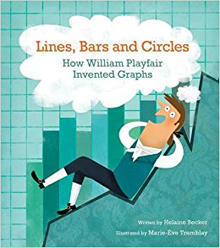 William Playfair (1759–1823), a Scott who dreamed big, invented graphs—line graphs, bar graphs, and pie charts—as ways of making data easier to understand. The scientists of his day, however, scoffed at his graphs. “Numbers showed serious works, colorful illustrations did not,” they declared. Playfair was also an entrepreneur who came up with numerous schemes for fulfilling his dreams of riches, fame, and glory, all of which failed. It was not until almost 100 years later that his graphs came into wide use. Digitally-created cartoon artwork adds humor to this picture book biography and provides a lesson in interpreting graphs.
William Playfair (1759–1823), a Scott who dreamed big, invented graphs—line graphs, bar graphs, and pie charts—as ways of making data easier to understand. The scientists of his day, however, scoffed at his graphs. “Numbers showed serious works, colorful illustrations did not,” they declared. Playfair was also an entrepreneur who came up with numerous schemes for fulfilling his dreams of riches, fame, and glory, all of which failed. It was not until almost 100 years later that his graphs came into wide use. Digitally-created cartoon artwork adds humor to this picture book biography and provides a lesson in interpreting graphs.
Up! Up! Up! Skyscraper. Anastasia Suen. Ill. Ryan O’Rourke. 2017. Charlesbridge.
 Young readers can join a small group of children in hardhats as a supervisor gives a tour of a construction site. Major steps in building a skyscraper are presented in double-page spreads with simple rhyming verses and brief paragraphs superimposed on digitally created illustrations. For example, an illustration showing a concrete mixer pouring out wet concrete is paired with “Pour, pour, pour! / Wet concrete / A line of mixers / Along the street” and an explanation (in smaller type) that it takes a lot of concrete to fill the trench in which the rebar cages have been placed. The final page folds out to reveal the completed skyscraper. Young children can learn more about skyscrapers by reading Libby Romero’s Skyscrapers (2017), a National Geographic Kids Reader.
Young readers can join a small group of children in hardhats as a supervisor gives a tour of a construction site. Major steps in building a skyscraper are presented in double-page spreads with simple rhyming verses and brief paragraphs superimposed on digitally created illustrations. For example, an illustration showing a concrete mixer pouring out wet concrete is paired with “Pour, pour, pour! / Wet concrete / A line of mixers / Along the street” and an explanation (in smaller type) that it takes a lot of concrete to fill the trench in which the rebar cages have been placed. The final page folds out to reveal the completed skyscraper. Young children can learn more about skyscrapers by reading Libby Romero’s Skyscrapers (2017), a National Geographic Kids Reader.
What Will Grow? Jennifer Ward. Ill. Susie Ghahremani. 2017. Bloomsbury.
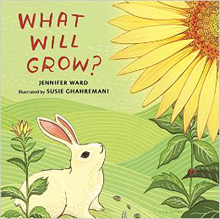 Rhyming couplets followed by the question “What will grow?” and gouache-on-wood illustrations offering visual clues to the answers introduce twelve seeds and the trees, flowers, fruits, or vegetables they grow into. Four gatefolds that open either up or down add to the fun of discovering whether readers’ answers are correct. For example, for “STRIPY BLACK. / CRUNCHY SNACK,” the right-hand page reveals a tall sunflower. Back matter includes information on planting each of the seeds and a “From Seed to Plant” section showing the life cycle of a sunflower.
Rhyming couplets followed by the question “What will grow?” and gouache-on-wood illustrations offering visual clues to the answers introduce twelve seeds and the trees, flowers, fruits, or vegetables they grow into. Four gatefolds that open either up or down add to the fun of discovering whether readers’ answers are correct. For example, for “STRIPY BLACK. / CRUNCHY SNACK,” the right-hand page reveals a tall sunflower. Back matter includes information on planting each of the seeds and a “From Seed to Plant” section showing the life cycle of a sunflower.
The Wolves Return: A New Beginning for Yellowstone National Park. Celia Godkin. 2017. Pajama Press.
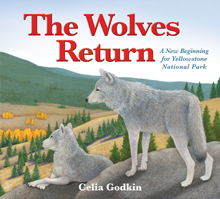 With an engaging, accessible text and expressive mixed-media illustrations, Godkin tells the environmental success story of the reintroduction of the grey wolf to Yellowstone National Park. In 1995–1996, 23 grey wolves from Canada were released in the park, after more than 70-year absence. Godkin chronicles the subsequent recovery of the landscape and the positive effects of the reintroduction of this top predator over the years, as plants and animals native to the area thrived in the ecosystem. An endnote, “The Wolf in North America,” provides history of the wolf and a map of the pre-European and current North American wolf range.
With an engaging, accessible text and expressive mixed-media illustrations, Godkin tells the environmental success story of the reintroduction of the grey wolf to Yellowstone National Park. In 1995–1996, 23 grey wolves from Canada were released in the park, after more than 70-year absence. Godkin chronicles the subsequent recovery of the landscape and the positive effects of the reintroduction of this top predator over the years, as plants and animals native to the area thrived in the ecosystem. An endnote, “The Wolf in North America,” provides history of the wolf and a map of the pre-European and current North American wolf range.
Ages 9–11
Karl, Get Out of the Garden!: Carolus Linnaeus and the Naming of Everything. Anita Sanchez. Ill. Catherine Stock. 2017. Charlesbridge.
 As a child growing up in Sweden, nature-loving Karl Linné (1707–1778) wanted to know the name of everything, but that could be confusing because a plant might have numerous common names. He set out to give everything a clear and simple name and to develop a classification system for all living things that is the basis for nomenclature and classification used by scientists today. In his lifetime, Karl classified and named more than 12,000 species of plants and animals, giving each a unique two-part name in Latin. He even gave himself a Latin-based version of his name: Carolus Linnaeus. Back matter includes additional information on scientific classification, a time line, source notes for quotations, resources for young readers, and a bibliography.
As a child growing up in Sweden, nature-loving Karl Linné (1707–1778) wanted to know the name of everything, but that could be confusing because a plant might have numerous common names. He set out to give everything a clear and simple name and to develop a classification system for all living things that is the basis for nomenclature and classification used by scientists today. In his lifetime, Karl classified and named more than 12,000 species of plants and animals, giving each a unique two-part name in Latin. He even gave himself a Latin-based version of his name: Carolus Linnaeus. Back matter includes additional information on scientific classification, a time line, source notes for quotations, resources for young readers, and a bibliography.
Skateboards (Made by Hand #1). Patricia Lakin. 2017. Aladdin/Simon & Schuster.
 After an identification of the parts of a skateboard (deck, trucks, and wheels) and a history of the skateboard, readers are introduced to Jake Eshelman, who designs custom skateboards for his company, Side Project Skateboards. The step-by-step process—everything from choosing the material for the deck to crafting shock absorbers—is explained and illustrated with color photographs. Back matter includes a skateboard time line, glossary, and resources.
After an identification of the parts of a skateboard (deck, trucks, and wheels) and a history of the skateboard, readers are introduced to Jake Eshelman, who designs custom skateboards for his company, Side Project Skateboards. The step-by-step process—everything from choosing the material for the deck to crafting shock absorbers—is explained and illustrated with color photographs. Back matter includes a skateboard time line, glossary, and resources.
Things That Grow. Libby Walden. Ill. Becca Stadflander. 2017. 360 Degrees/Tiger Tales.
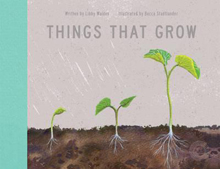 This beautifully designed book, with its small trim size, heavy paper, accessible narrative, and colorful, realistic illustrations, invites curious readers to explore the processes of development and growth of things in our diverse and ever changing world. The three sections—“Plants and Trees,” “The Animal Kingdom,” and “The Universe”—contain double-page spreads that introduce key concepts of the development of plants, animals, and features of our planet along with examples, such as the growth and survival of plants in extreme conditions; the unusual life cycle of the axolotl (the Mexican walking fish), a neotenic aquatic salamander; and the creation of islands.
This beautifully designed book, with its small trim size, heavy paper, accessible narrative, and colorful, realistic illustrations, invites curious readers to explore the processes of development and growth of things in our diverse and ever changing world. The three sections—“Plants and Trees,” “The Animal Kingdom,” and “The Universe”—contain double-page spreads that introduce key concepts of the development of plants, animals, and features of our planet along with examples, such as the growth and survival of plants in extreme conditions; the unusual life cycle of the axolotl (the Mexican walking fish), a neotenic aquatic salamander; and the creation of islands.
Ages 12–14
Beastly Brains: Exploring How Animal Think, Talk, and Feel. Nancy F. Castaldo. 2017. Houghton Mifflin Harcourt.
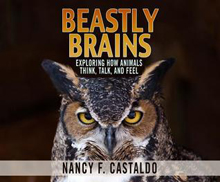 Following an introduction to the human brain in comparison to the those of other animals and a history of theories on animal intelligence, Castaldo delves into recent research exploring animal cognition. In a conversational tone, she presents information on numerous studies on problem solving, communication, tool use, and emotions in various animals. Castaldo ends with a “From Thinking Animals to Protected Animals” section about how the recognition of the intelligence of animals is changing how we see animals and affecting our treatment of them. Back matter includes activities for young people, lists of organizations and resources, a glossary, source notes, a bibliography, and an index.
Following an introduction to the human brain in comparison to the those of other animals and a history of theories on animal intelligence, Castaldo delves into recent research exploring animal cognition. In a conversational tone, she presents information on numerous studies on problem solving, communication, tool use, and emotions in various animals. Castaldo ends with a “From Thinking Animals to Protected Animals” section about how the recognition of the intelligence of animals is changing how we see animals and affecting our treatment of them. Back matter includes activities for young people, lists of organizations and resources, a glossary, source notes, a bibliography, and an index.
Botanicum (Welcome to the Museum). Kathy Willis. Ill. Katie Scott. 2017. Big Picture/Candlewick.
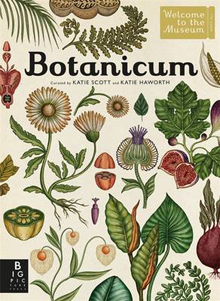 A “Welcome to Botanicum” extends an invitation to visit a botanical museum to “discover the strange and wonderful kingdom of plants, in all its colorful, surprising majesty.” A tour through the seven galleries—“The First Plants,” “Trees,” “Palms and Cycads,” “Herbaceous Plants,” “Grasses, Cattails, Sedges, and Rushes,” “Orchids and Bromeliads,” and “Adapting to Environments”—introduces readers to the extraordinary diversity of the plant world. Each double-page spread of this beautifully crafted, oversize volume consists of a plate of pen-and-ink, digitally colored drawings of plants (or plant parts) accompanied by an introduction and key to the plate, with common and scientific names and brief descriptive and environmental notes on each plant. Back matter includes an index and internet resources.
A “Welcome to Botanicum” extends an invitation to visit a botanical museum to “discover the strange and wonderful kingdom of plants, in all its colorful, surprising majesty.” A tour through the seven galleries—“The First Plants,” “Trees,” “Palms and Cycads,” “Herbaceous Plants,” “Grasses, Cattails, Sedges, and Rushes,” “Orchids and Bromeliads,” and “Adapting to Environments”—introduces readers to the extraordinary diversity of the plant world. Each double-page spread of this beautifully crafted, oversize volume consists of a plate of pen-and-ink, digitally colored drawings of plants (or plant parts) accompanied by an introduction and key to the plate, with common and scientific names and brief descriptive and environmental notes on each plant. Back matter includes an index and internet resources.
Ages 15+
A Dog in a Cave: The Wolves Who Made Us Human. Kay Frydenborg. 2017. Houghton Mifflin Harcourt.
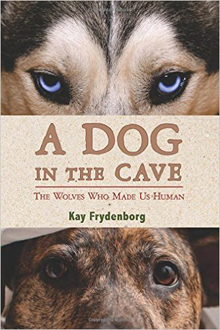 In this exploration of the human–dog relationship, Frydenborg considers how a shared history has influenced the development of both humans and canines. Recent paleontological discoveries show that humans have been living with dogs for thousands of years longer than was previously thought, and there is evidence that this close relationship has shaped the evolution of both species as they coevolved. Frydenborg also considers present-day scientific research on dogs that supports this concept. An abundance of color photographs with extensive captions and inserts on related topics add interest. Back matter includes a glossary, source notes, a selected bibliography, internet resources, and an index.
In this exploration of the human–dog relationship, Frydenborg considers how a shared history has influenced the development of both humans and canines. Recent paleontological discoveries show that humans have been living with dogs for thousands of years longer than was previously thought, and there is evidence that this close relationship has shaped the evolution of both species as they coevolved. Frydenborg also considers present-day scientific research on dogs that supports this concept. An abundance of color photographs with extensive captions and inserts on related topics add interest. Back matter includes a glossary, source notes, a selected bibliography, internet resources, and an index.
Never Out of Season: How Having the Food We Want When We Want It Threatens Our Food Supply and Our Future. Rob Dunn. 2017. Little, Brown.
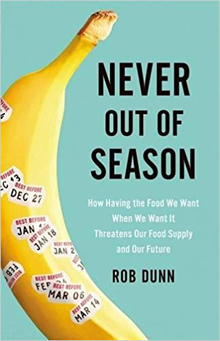 Rob Dunn, a professor of applied ecology, offers an accessible, well-researched history of the world’s food system in which relying on just a few crops to sustain populations throughout the world and our desire for consistency, uniformity, and abundance in our food —“having the food we want when we want it”—threatens agricultural sustainability. Dunn provides details of examples of how the dependence on genetically identical crops and cloning have led to greater susceptibility to pathogens, crop failure, and even famine, as in the case of the Irish potato famine in the 1840s. World-wide monoculture remains the norm: corn in North America, rice in Asia, cassava in Africa, and wheat in Europe. In highlighting the efforts of scientists to preserve biodiversity, Dunn provides a compelling argument for changes in agricultural practices to save our food supply and our future. Back matter includes extensive chapter notes and an index.
Rob Dunn, a professor of applied ecology, offers an accessible, well-researched history of the world’s food system in which relying on just a few crops to sustain populations throughout the world and our desire for consistency, uniformity, and abundance in our food —“having the food we want when we want it”—threatens agricultural sustainability. Dunn provides details of examples of how the dependence on genetically identical crops and cloning have led to greater susceptibility to pathogens, crop failure, and even famine, as in the case of the Irish potato famine in the 1840s. World-wide monoculture remains the norm: corn in North America, rice in Asia, cassava in Africa, and wheat in Europe. In highlighting the efforts of scientists to preserve biodiversity, Dunn provides a compelling argument for changes in agricultural practices to save our food supply and our future. Back matter includes extensive chapter notes and an index.
Carolyn Angus is former Director of the George G. Stone Center for Children's Books, Claremont Graduate University, CA.
These reviews are submitted by members of the International Literacy Association's Children's Literature and Reading Special Interest Group (CL/R SIG) and are published weekly on Literacy Daily.